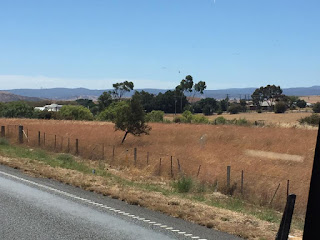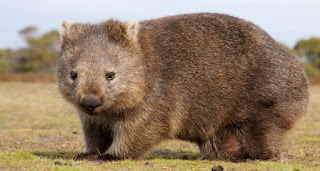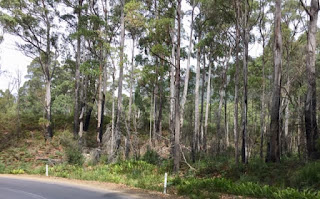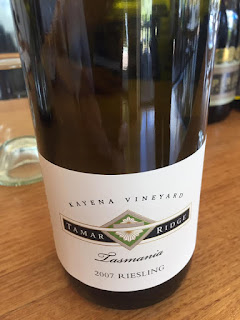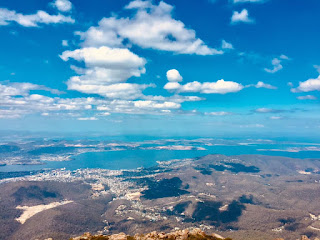I'd booked a cruise on the Coral Discoverer (7 days - Hobart to Hobart) and decided to extend it a few days before the ship, and a few days after.
Look what was sitting on my suitcase when I arrived Sunday afternoon in Hobart, Tasmania! A Tasmanian Devil!

Pippi Longstocking and I scored a great hotel that looks out over Hobart harbor! Tonight when we strolled around, a full moon greeted us. (It’s summer here in the Antipodes; sunset happens around 8:45)



En route to the famous (and somewhat controversial) MONA museum near Hobart. Google it for more background. I’ll post some selected pix. I’ve already seen some which don’t make it past my PG screen ... so that’s why it’s controversial for some art tourists. Very interesting, I’ll say that!



Less about art, and more about the experience of getting to and walking around MONA: camouflage painted luxury catamarans take you for a nominally-priced ticket from the harbor in Hobart to the site of the museum, about a 20 minute ride. One of the first things you see in the museum is this beer roulette machine… Yes, it does dispense canned beer, but you don’t know in advance what you are going to get. This seems an appropriate piece of art, Or is it simply a vending machine?, Installed by the museum’s creator, who made his money as a card counter in casinos… A taxi driver told me that he made $30 million counting cards before he was banned from casinos worldwide. What a fascinating story! More information on the Internet, I am sure… Nonetheless, this museum draws thousands of tourists to Hobart, and has expanded to include two major art and music festivals here each year.


Art that resonated with me at MONA museum near Hobart: “Fat Car” which is a work done on a Porsche Carrera chassis and a commentary on materialism and gluttony of various sorts; “Snake” is a mural 150 feet long and 30 feet high comprised of individual photos with some highlighted to suggest the Rainbow Serpent shape (an important part of Aboriginal mythology/origin story), and a waterfall creation with synchronized droplets that are lit as random words are computer controlled. HOWEVER, there are a few galleries showing art that some might consider pornographic (I’m not one to censor); but I personally found it deeply offensive. Must be getting old...🙁




This wonderful dish from the Faro restaurant at MONA museum. Drink: 2018 morilla praxis sparkling riesling, Tasmania. The entrée: sherry master stock poached chicken, grilled prawns, fennel cream, green olive purée, Fino (the Sherry used), and on top, a deep fat fried piece of chicken skin. The views from the restaurant are incredible!

You know that old expression about celebrating good fortune, “My ship has come in.”? I felt such joy to see the Coral Discoverer enter Hobart harbor this Tuesday morning at 8, right on time. It will take most of the day to ready it for my arrival on board today at 4. In the meantime ... historical Hobart, here I come!
January 22, 2019 Tuesday in Hobart got off to a pleasant start with a chat with Gerald, proprietor of the antique map shop near the harbor. He’s got some nice Tasmania maps! Then on for a late breakfast at the Harbour Lights Cafe. Afternoon tour of the Cascades Female Factory (convict women’s workhouse) and a living history performance. In case you are wondering, I organize all this stuff myself...
At its peak, more than 1200 women at a time, with their children under 2 years old, were held at the Cascades Female Factory near Hobart after being transported from the UK for petty crimes, beginning in 1828 until 1856. After serving their time, many married the “free” settlers here in Tasmania . Horrific stories of maltreatment, terrible living conditions, high mortality of newborns etc ... dramatically presented in HER STORY, a living history performance and walk at what remains of the site. @Livehistoryplays. (Of course the original Tasmanian natives were the aboriginals, and that’s another sad and shameful episode...). Ah, colonial history in all its Glory... or is that “Gory”?
ONTO THE CORAL DISCOVERER!
OUR FIRST EXCURION –
Our first excursion, Wednesday morning, was to take the Xplorer tender to Woodbridge where we learned about the process of sheep cheese-making at the family-run Grandvewe Cheeses. Delicious and uniquely flavored cheeses - my favorite was “Herbalist”, a semi-soft cheese that’s rolled in the botanicals left over from their whey gin making operation. These dairy sheep have a wonderful life due to the ethical farming principles hewed to by owner Diane . And what a view they have, of Birchs Bay in the D’Entrecasteaux Channel!
Other interesting sights in and around the small town of Woodbridge Tasmania
One of the things I like about traveling on this small ship, the Coral Discoverer, is the open bridge policy. I can go anytime of day or night to visit the navigators and pilots. They patiently show me where we are on the nautical charts... and who doesn’t love nautical charts? For instance, today’s journey if you look closely goes right past Eggs
and Bacon Bay
We learned about the history of wooden boat building in Tasmania at the Wooden Boat Centre in the town of Franklin on the Huon River. Here, you can take a course and build a skiff from start to finish.
Lots of boating activity here!

Lots of boating activity here!


Learning about boat building is thirsty work, so Pippi Longstocking and I ambled across the street to Frank’s Cider Co. Hmmm what shall we have? Oh no, Pippi, this is alcoholic cider, with from 3.5-6% alcohol!
BATHURST BAY ~ I wasn’t expecting that familiar smell of burning wood seeping into our expedition ship on the morning of January 24, but sure enough the wilderness areas of Tasmania are currently experiencing a lot of wildfires! The tranquil waters generally provide incredible views, but today the smoke is bad. Still, the reflections are lovely.
An excursion in Bathurst Harbor took us to this landing. All kinds of characters seem to have been attracted to this Southwest corner of Tasmania. We were cautioned, on our rainforest walk, to be alert for these small but poisonous ants, “Jack Hoppers.” Our expedition leader actually carries an EpiPen just in case... oh yes, be careful of the snakes too!
The lighthouse at Cape Bruny is the third oldest lighthouse in Tasmania, built with convict labor in 1836 after several shipwrecks happened nearby. The Nuenonne tribe of aboriginals were located here. Evidence of Aboriginal life in Tasmania dates back 37,000 years.
Truganini, the last remaining full-blooded Aboriginal, died on Bruny Island in 1873. There is an excellent book that I read in preparation for this trip, recommended by anthropologist Shirley Campbell, on the “Black War” waged to eradicate Tasmanian Aboriginals. A lookout on the isthmus that separates the two land masses that constitute Bruny Island is named in Truganini’s honor.
Friday January 25 - The smoke from wildfires all over Tasmania made it impossible to clearly see Tasman Island and the lighthouse on its top. The 1000-foot tall dolorite cliffs were visible but just barely. Seas so roughly I actually took a seasickness pill - a first time for me (I never get seasick!). Photos below courtesy of our lecturer... taken in nicer weather.
Saturday January 26 - Australia Day. Flags flying on the ship as we took the tender to the Crockett’s beach on Schouten Island, part of Freycinet National Park. We did a walk through some scrub to a further beach, where among other natural wonders there was a Decorator Crab’s shell (they decorate their shell with rocks, seaweed etc as camouflage against predators) and beautiful sandstone formations interspersed with the granite and dolomite that characterizes the geology of these islands.
During Saturday afternoon’s excursion to Wineglass Bay, part of Freycinet National Park, walking the white sand beach gave us time to reflect on the name of this bay. The curve of the bay is similar to the curve of a red wine glass. Red wine because... during the years of heavy whaling, right whales would he harried into the bay for slaughter, and the water of the bay was red with whale blood. Whale oil fueled many settlers lamps in those days...
Sunday morning on Maria Island off the East coast of Tasmania, now a national park. Originally used as the site of a jail for convicts, then as a coal mining area, and some optimistic person started a vineyard. Now the settlement of Darlington, SF it’s called, has a small museum with artifacts from the time of Queen Victoria, and the convict quarters have been redone as family holiday rentals that offer a reprieve from civilization... no cars, no shops and no TV ... just the outdoors and plenty of wildlife.
Animals freely roam Maria Island. It’s one of the few places you can see a Tasmanian Devil, plus wombats and kangaroos.
Sunday afternoon 27th January in Tasmania ~ it’s become so windy that we’re on the ship cruising down the east coast, past Pirates Bay and Waterfall Bay, in awe of the incredible rock formations and cliffs. Our naturalist says this is a famous diving spot.


Monday morning January 28, Pippi Longstocking lands comfortably at Port Arthur. This was not the case in 1857 when a flour mill was converted into a penitentiary for waves of convicts transported from England, most for minor thefts. This building eventually held 2000 prisoners. It was an ideal location for a prison, surrounded on 3 sides by water with an easily guarded narrow neck the only way out. The facility was closed in 1877 when the convict eta at Port Arthur was officially over.
Monday afternoon I thought I’d be exploring Bruny Island and the Bligh museum (as in Captain Bligh). But the wildfire activity and westerly winds brought this not-so-pretty picture to view outside our ship. Bright side: plenty of time to learn some nautical terms and look at maps on the “bridge” where the Captain controls the ship.
Tuesday Jan 29 ~ farewell to The Coral Discoverer and hello BeeLine bus from Hobart to Launceston in Tasmania’s north-central region.
The bus passed by beautiful vistas of the Derwent River Valley with wInegrape vineyards, wheat-oat-and-opium-poppy* growing areas, sheep and black angus ranches, cherry and other orchards, and in 3 comfortable hours arrived in Launceston. *(Tasmania produces more than half of all medical opium)
The bus passed by beautiful vistas of the Derwent River Valley with wInegrape vineyards, wheat-oat-and-opium-poppy* growing areas, sheep and black angus ranches, cherry and other orchards, and in 3 comfortable hours arrived in Launceston. *(Tasmania produces more than half of all medical opium)
Launceston is set near the confluence of three rivers: the North Esk, South Esk, and Tamar Rivers. Pippi Longstocking wanted to see the Cataract Gorge, where the South Esk tumbles into the Tamar. A beautiful short cruise!
January 30 TRIP TO CRADLE MOUNTAIN!
Sheffield, Tasmania’s TOWN OF MURALS... an interesting stop on the road between Launceston and Cradle Mountain.
Another interesting small town on the way to Cradle Mountain is Railton, known for its topiary art. Resident Neil Hurley started talking about turning Railton into the "Town of Topiary" in 1999 and this idea grew into the town’s major tourist attraction. Certainly worth a drive-through
Cradle Valley ~ absolutely stunning wilderness area, the result of Ice Age actions. A favored tourist destination with good tours, and some hardly folks walk the trail from Mountain to Mountain, which takes 5-6 days. I was happy with a day tour via McDermott’s Coaches and our naturalist guide Ben.
Gustav Weindorfer, an Austrian immigrant, was determined that the beauty of Cradle mountain would be preserved as a national park. Although his personal story is a bit of a tragic one, he met his goal. Somewhat of a hermit, he built a rustic homestead in the Cradle Valley wilderness, called Waldheim, where he died in 1932. Near his homestead are some of the last remaining Antarctic rain forest stands.
Disturbing things I learned about wombats from our naturalist at Cradle Mountain National Park: 1) their poop is cube-shaped. 2) they are cranky. (Images courtesy science.org)
Finally, at the end of the Cradle Mountain Day - A chance to see the elusive Tasmanian Devil. We stopped at the “Devils @ Cradle”, a unique Tasmanian conservation sanctuary. The sanctuary concentrates primarily on the Tasmanian devil, but is also home to the closely related Spotted-tail and Eastern quolls. Tasmania’s three largest carnivorous marsupials are all now threatened in one way or another in the wild.
On the way back to Launceston from Cradle Mountain, our guide pointed out burn marks on trees at the side of the road. Fire stick farming, a technique which originated in Tasmania with the aboriginal population, provides for occasional burning of woodlands to clear the undergrowth and brush. Moving from location to location, the land thus cleared allows for differing stages of regrowth, and the animal population would move into those regrowth areas, thus providing a protein food source for the aboriginals. Today, this technique is still employed by today’s current landowners, as you can see from the burn marks halfway up the trees at the side of many roads.
A lot of Tasmania is still in pasture land, and the dairy industry is thus a significant one in this part of Australia.
On the way back to Launceston, we stopped at Ashgrove Farm and enjoyed tasting many of their cheeses. They’ve got a picnic area where customers can enjoy their purchases, and take photos with the decorated cows!
January 31, 2019 TAMAR VALLEY WINE TOUR
The Tamar River meanders for almost 40 miles through the countryside to the north of Launceston. There are over 30 wineries to explore, with Chardonnay, Riesling, Sauvignon Blanc, Pinot Grigio, and other varieties grown in the vineyards. The sparkling wines from Tasmania have gained international acclaim. One of the best that I tasted on my wine tour is the 2011 Pirie Vintage sparkler from Brown Brothers Milawa Vineyard. This winery also produced a wonderful Riesling. The region reminds me of the Sierra Foothills, with boutique family run wineries tucked away off twisting foothills roads.
The Tamar Valley wine tour featured a stop at Swinging Gate vineyard and winery in Sidmouth. Among the adventurous wines produced here is an Amarone style wine. Pippi Longstocking made a friend of Nellie, the winery dog. Charming tasting room, and Doug is an interesting winemaker. Put it on your wine tour list when you get to Launceston, Tasmania.
Back in Hobart, I stayed in the Henry Jones hotel, built in a refurbished jam factory on the waterfront of Hobart. In my room was a message from the hotel alerting me to the fact that the country on which Hobart is situated has been the traditional living, hunting and spiritual lands of the aboriginal Mouheneener clan for at least 800 generations. Greeting me was also the result of a search for my name in a database of convicts transported to Tasmania. Although there were no results for “Barbara Keck“, the hotel included results associated with Henry Jones, the namesake of the hotel. Want to find out if you are related to any of the convicts transported (mostly from England and Ireland) to Tasmania in the 1800’s? Here is the URL to search: https://linctas.ent.sirsidynix.net.au/…/names/search/results?
February 1 afternoon ~ there was still time for a visit to the nearby Tasmanian Museum And Art Gallery, Hobart’s natural history and cultural history museum. I am always interested in first people‘s cultures, so I was delighted to find some wonderful galleries devoted to Tasmania‘s aboriginal past. A film depicting aboriginal ceremonial dance was playing, and also exhibits showing how Aboriginal people harvested red kelp to make water carriers and other useful baskets. The Tasmanian history of purposeful eradication of their aboriginal population is grim and sad. No more pure blooded aboriginals remain in Tasmania, although through intermarriage there is a population that continues both the bloodline and lobbies successfully for recognition of aboriginal rights and preservation of the history and culture.
February 1 afternoon ~ there was still time for a visit to the nearby Tasmanian Museum And Art Gallery, Hobart’s natural history and cultural history museum. I am always interested in first people‘s cultures, so I was delighted to find some wonderful galleries devoted to Tasmania‘s aboriginal past. A film depicting aboriginal ceremonial dance was playing, and also exhibits showing how Aboriginal people harvested red kelp to make water carriers and other useful baskets. The Tasmanian history of purposeful eradication of their aboriginal population is grim and sad. No more pure blooded aboriginals remain in Tasmania, although through intermarriage there is a population that continues both the bloodline and lobbies successfully for recognition of aboriginal rights and preservation of the history and culture.
February 2~ The famous Saturday market in Hobart, just steps away from the waterfront, is the “Salamanca market” that draws visitors from all over the world. There are hundreds of local vendors of food, clothing, produce, and the street scene is very colorful indeed! One jewelry vendor was distracted by her need to care for an orphaned baby wallaby...
A quick tour from Hobart’s waterfront to kunanyi/Mt Wellington, which rises majestically 4000 feet above Hobart. As a matter of respect to its original app original owners, this landmark now has both the aboriginal and the English name applied to it. The mountain’s geology is primarily Dolerite rock columns, formed from cooling lava flows eons ago.
What better place to eat fresh seafood than on Hobart’s waterfront? Several fish and chip vendors have docked their houseboat type restaurants in the marina right outside the hotel. A huge cruise ship of Holland America line was in port all day, disgorging its 1900 passengers into town. However, that did not affect the beautiful sunset scene.
Remember the commentary above, regarding heavy seas overnight? Today at the Maritime Museum in Hobart, which has a great exhibit of famous shipwrecks, I scrounged this photo from an exhibit on ships and sailors lost over the years during the annual Sydney to Hobart yacht race that begins the day after Christmas. Although the Coral Discoverer trip that I’ve just taken does not go into the treacherous waters of the Bass Strait where this photo was taken, the company DOES DO a trip every year where they sail alongside the racing yachts. Anyone want to join me?
My trip to Tasmania ended after 14 wonderful days. Then -- on to Melbourne/mainland Australia ~ a quick 1 hour 15 minute flight from Hobart on Qantas, Jetstar and a number of other budget airlines.
For the blogpost on Melbourne, click here























































